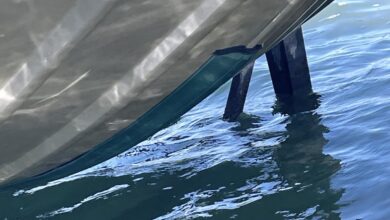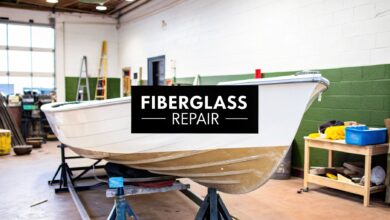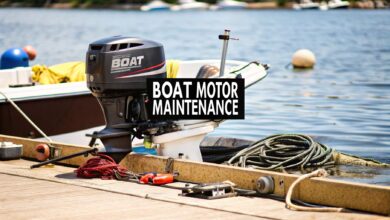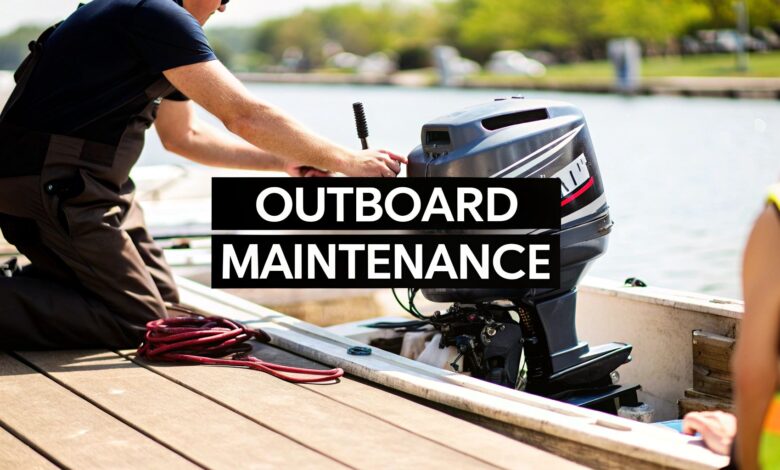
A great day on the water often comes down to one thing: consistent outboard motor maintenance. The secret isn't being a master mechanic. It's about building a simple, repeatable routine before and after every trip.
These habits are your best defense against common failures that leave boaters stranded.
Your Essential Pre-Launch and Post-Trip Routine
Think of the most reliable boater you know; they are likely consistent with their checks. They have a routine of quick visual inspections that spot small issues early. This discipline provides peace of mind and keeps your engine ready to go.
Your routine starts with a quick walk-around before you launch. Give the fuel system a once-over. Check for cracks in the fuel lines and ensure the primer bulb is soft and pliable.
Look for any drips or wet spots that signal a leak. These simple components are common failure points but are easy to spot on the trailer.
Quick Visual Inspections
Next, give the propeller a spin. You’re looking for dings, scratches, or tangled fishing line. A damaged prop hurts performance and can cause vibrations that wear on your engine.
While you're back there, peek at the battery connections. They should be snug and clean, with no corrosion.
More boat owners realize that prevention is key. The global market for outboard motor rebuild services was valued at USD 0.15 billion in 2023 and is projected to climb by about 8% annually. This shows a massive trend toward extending engine life through proper care, and you can learn more about the market's growth and what it means for boat owners.
"Forget the dense manual for a moment. The best habit you can build is the five-minute inspection at the dock. It catches 90% of the issues that leave people stranded."
Once you've launched, glance over the side to confirm a strong "telltale" stream of water. That's your cooling system's heartbeat.
When your day is done, flush the engine with fresh water. This is non-negotiable, especially after running in saltwater. It’s a simple task that prevents internal corrosion.
A consistent checklist makes these habits stick. Here’s a quick-reference table to help you build that routine.
Pre-Launch vs. Post-Trip Maintenance Checks
| Check Area | Pre-Launch Action | Post-Trip Action |
|---|---|---|
| Fuel System | Inspect fuel lines for cracks; check primer bulb condition. | Check for any new fuel smells or signs of leaks. |
| Propeller | Check for dings, damage, or tangled fishing line. | Give it another quick visual check for new damage. |
| Battery | Ensure terminals are tight and free of corrosion. | N/A |
| Engine Cowling | Check that the cowling is securely latched. | Remove cowling to look for water or fuel leaks. |
| Cooling System | Visually confirm a strong telltale stream after startup. | Flush the engine thoroughly with fresh water. |
| General Visual | Look for any loose bolts, wires, or obvious issues. | Wipe down the engine and cowling to spot issues. |
Making this table part of your routine turns maintenance from a chore into a powerful habit. It protects your investment and ensures trouble-free days on the water.
Getting Your Hands Dirty: Core Service Tasks You Can Tackle
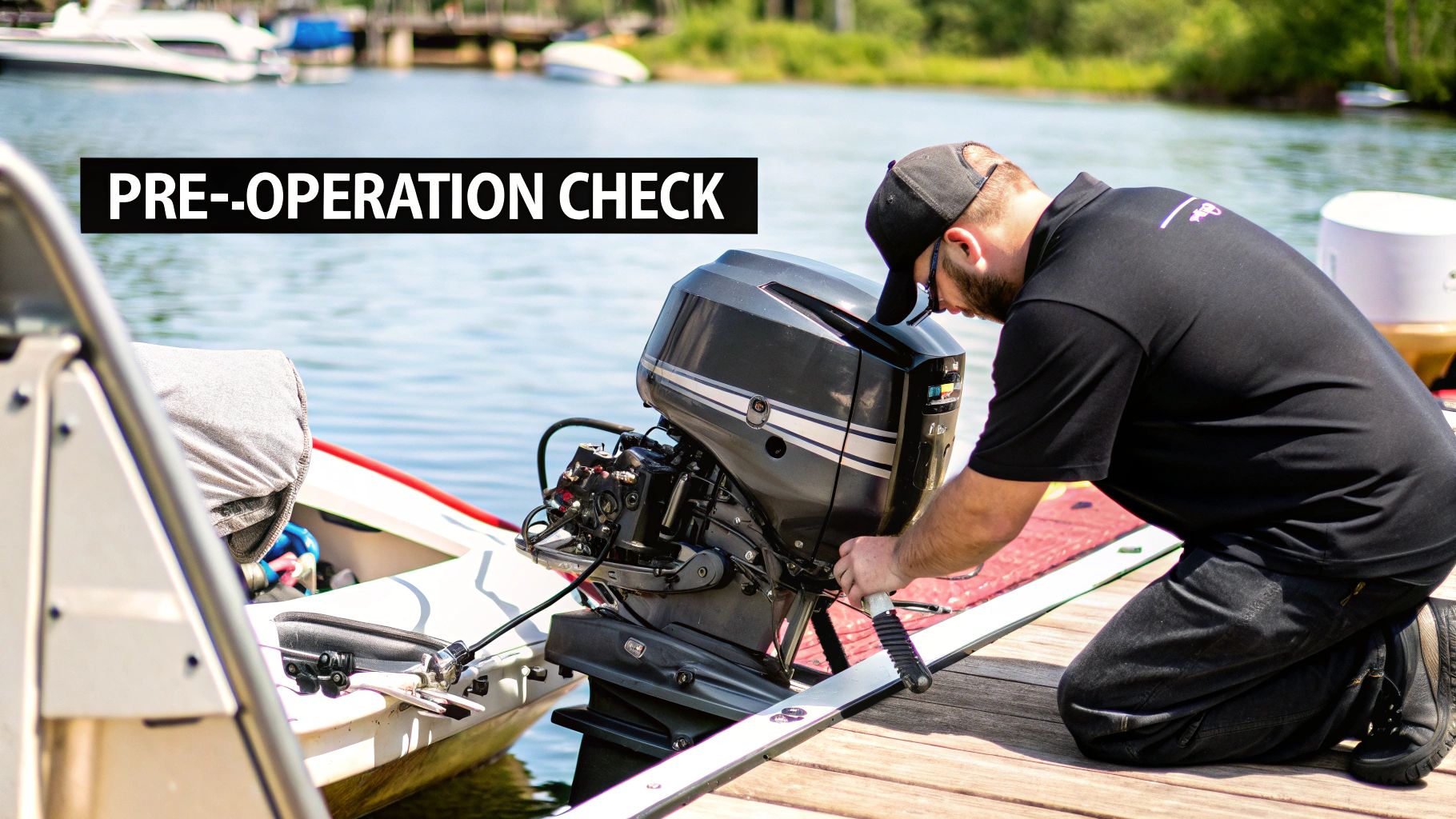
Let's move past simple checks and get into the real work. This is where you take ownership of your engine's longevity. Doing your own oil changes and replacing gearcase lube builds confidence.
These aren't just boxes to tick on a maintenance list. They are essential procedures for flushing out things that cause expensive damage.
When you drain old engine oil, you remove microscopic metal shavings and moisture. The same is true for the gear lube. If the old lube is milky, water has breached a seal, and catching it early prevents lower unit failure.
Key Service Points for a Healthy Engine
Your engine's reliability often boils down to a few critical components. Pull your spark plugs at least once a season. It’s like getting a report from inside the combustion chamber.
Swapping them is a cheap and easy job that pays off with better starts and smoother running.
Another must-do is checking the fuel filter. This canister protects your injectors from debris, water, and gunk. A clogged filter will starve your engine for fuel, leading to sputtering and stalling.
I’ve found that a clean, organized workspace makes these jobs smoother. Even in a garage, many concepts for setting up an efficient automotive workshop can be applied to create a great maintenance spot.
Mastering these fundamental tasks turns a good engine into a great, dependable one.
Protecting Your Fuel System From Failure
Let’s talk about your outboard's fuel system. It's the engine's lifeline, but it's under constant assault from modern ethanol-blended fuels. Most problems that strand boaters are tied directly back to a fuel system failure.
Marine-grade fuel stabilizer isn't just for winterizing; it should be a year-round habit. The ethanol in pump gas is hygroscopic, meaning it loves to pull moisture from the air. This water can settle in your tank and get sucked into your engine, causing corrosion.
Inspecting Key Fuel Components
The weakest links in your fuel system are rubber and plastic parts. Squeeze your fuel lines from the tank to the engine. They should feel flexible, not hard or brittle.
Next, give the primer bulb a few pumps. It should feel firm and pop back into shape. If it stays squished or won't firm up, its internal check valves have likely failed.
A healthy fuel system is the bedrock of reliable outboard motor maintenance. A small investment in quality fuel additives and a few minutes of inspection will prevent most engine problems.
The global outboard motor market is projected to grow from USD 5.75 billion in 2024 to nearly USD 5.98 billion by 2033. This growth is driven by the recreational boom. You can discover more insights about this market expansion on marineindustrynews.co.uk.
Finally, don't forget the water-separating fuel filter. This canister is your engine’s last defense against water. Checking and changing it on schedule is one of the most important tasks for long-term reliability.
A Realistic Guide to Winterizing Your Outboard
Properly winterizing your outboard is the most important thing you can do for its long-term health. Cold weather and moisture are your engine's worst enemies during storage. A few straightforward steps can prevent expensive damage.
First, let's talk fuel. Before your last run, add a quality marine fuel stabilizer to your tank. Then run the engine for about 15 minutes to circulate the stabilized fuel through the entire system.
With the engine running on a water supply, it's time to fog it. Spray fogging oil into each carburetor's air intake until you see thick smoke and the engine stalls. This coats internal surfaces with a protective film, warding off rust.
Draining and Changing Critical Fluids
Now for the most critical part: getting the water out. If water freezes inside your engine, it can expand and crack the engine block. Make sure every drop is drained from the cooling system.
Once that's done, shift your focus to the lower unit. Changing the gearcase oil is a non-negotiable task. It's also your best chance to spot a problem before it gets out of hand.
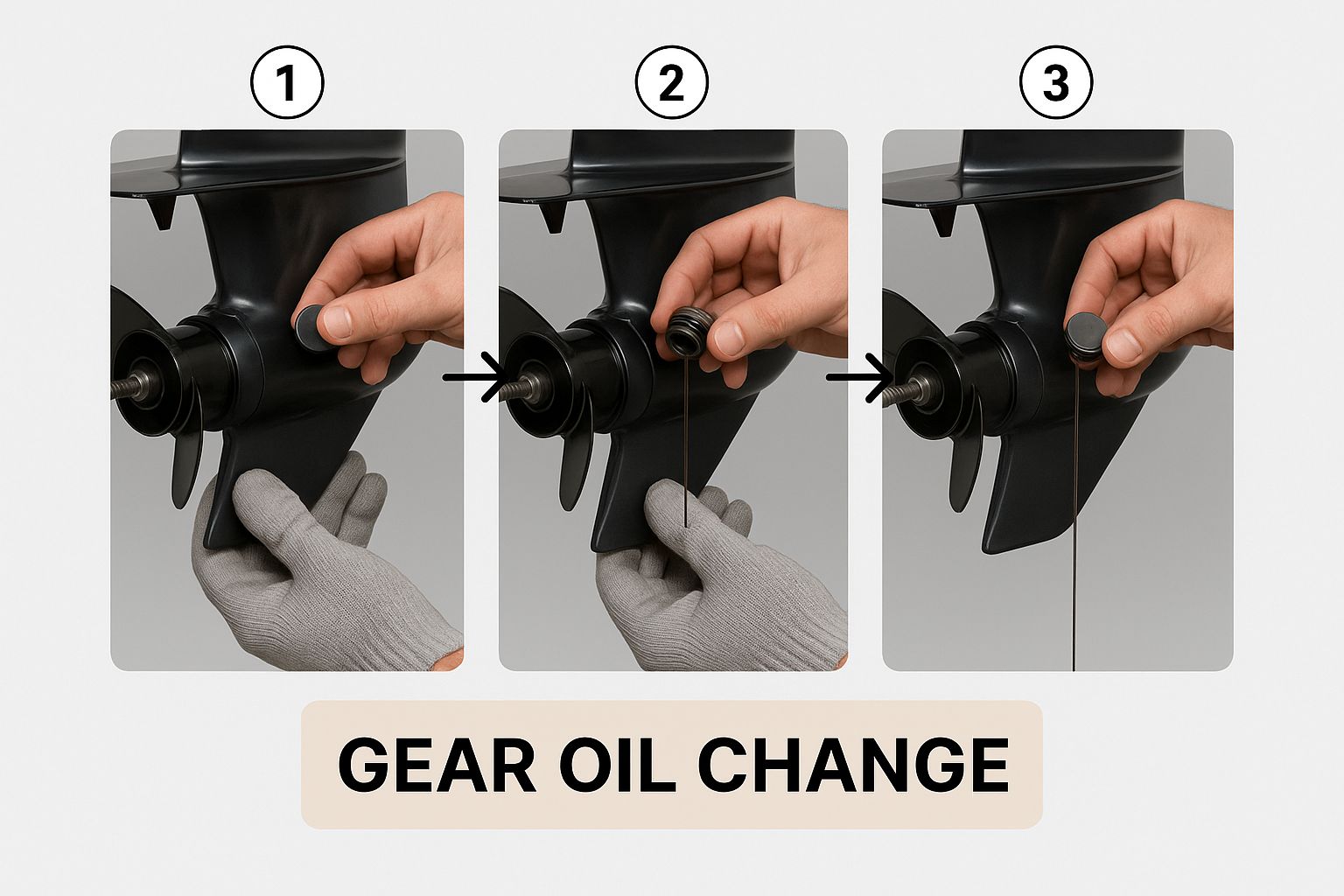
As you can see, this isn't just a chore; it's a diagnostic check. For a more detailed walkthrough, our complete winterize boat checklist covers everything you need to know.
Pro Tip: When you drain the old gear lube, pay attention to its color. If it looks milky or creamy, that's a sign of water intrusion. Finding this in the fall gives you all winter to get it fixed.
Protecting your motor is more important than ever. In 2024, recreational boating made up about 75% of the outboard motor market, valued at around USD 4.54 billion. You can learn more about these market findings.
To keep your outboard in top shape, it helps to follow a consistent schedule. Sticking to a routine prevents small issues from becoming big problems.
Seasonal Maintenance Task Schedule
This table breaks down essential maintenance tasks by how often you should perform them.
| Task | Frequency | Key Benefit |
|---|---|---|
| Fuel System Treatment | Annually/Winterization | Prevents fuel degradation and system gum-up. |
| Fogging Engine Internals | Annually/Winterization | Coats internal parts to prevent rust and corrosion. |
| Gearcase Lube Change | Every 100 Hours or Annually | Lubricates gears and allows for water intrusion inspection. |
| Water Pump Impeller | Every 100-200 Hours or Annually | Ensures proper engine cooling to prevent overheating. |
| Spark Plug Inspection | Every 100 Hours | Monitors engine combustion health and ensures reliable starts. |
| Grease Fittings | Every 50-100 Hours | Protects steering and tilt mechanisms from corrosion and wear. |
Following a simple schedule like this takes the guesswork out of maintenance.
Troubleshooting Common On-the-Water Issues
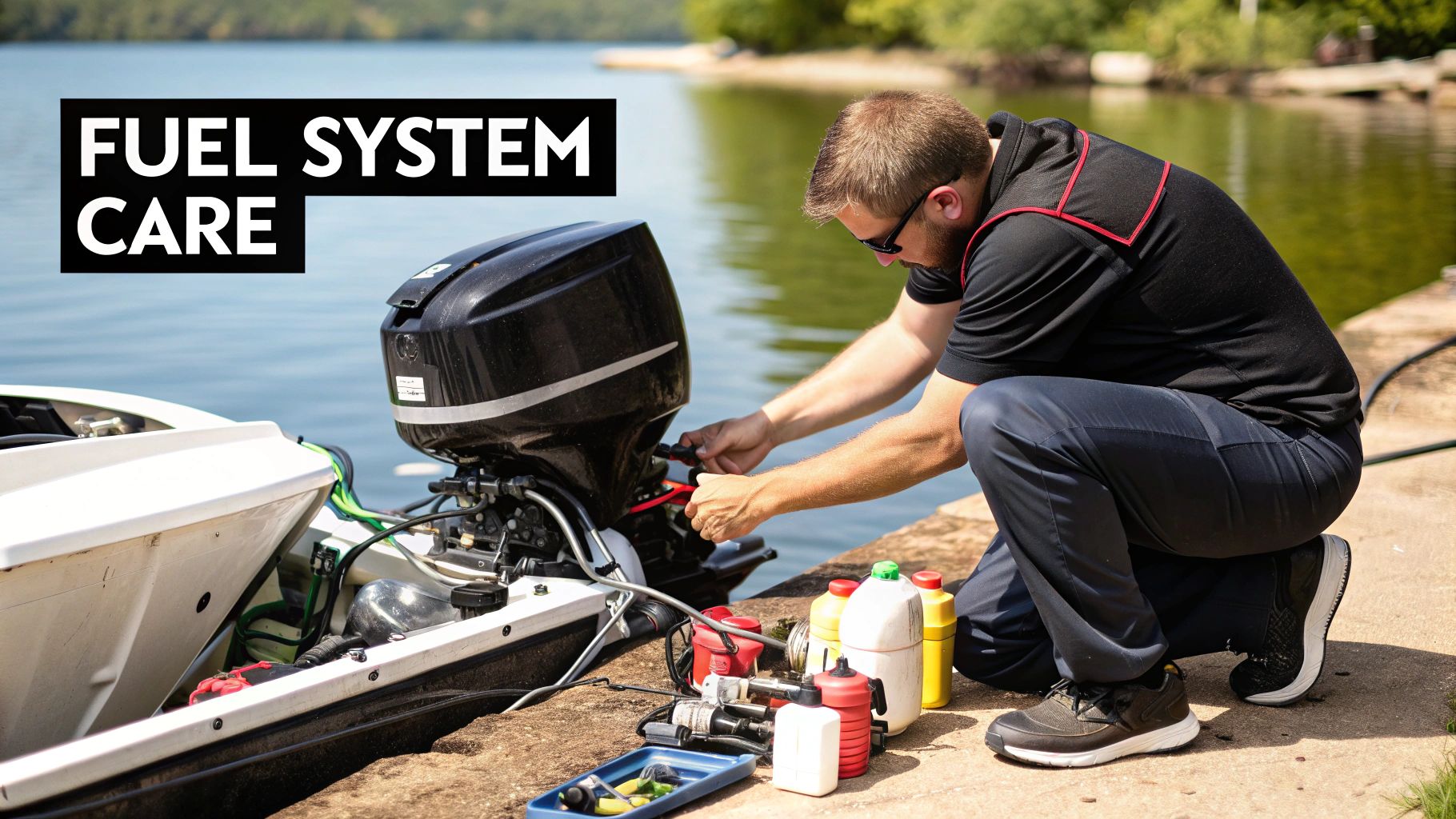
Even a well-maintained outboard can have a bad day. The real test is knowing how to diagnose a problem on the water. Think of this as your quick-reference guide.
If the engine won't turn over, start with the simple stuff first. A "dead" engine is often just a disconnected kill switch lanyard or the shifter not being in neutral. Check those two things first.
Is your motor sputtering or did it suddenly lose power? My mind goes to the fuel system. Squeeze the primer bulb; if it feels soft, you likely have a fuel delivery problem.
Responding to Overheating
An overheating engine is a serious problem that demands immediate action. You'll usually get an alarm or a warning light. Check the "telltale" stream of water—this is your cooling system's vital sign.
If that stream is weak or gone, shut the engine down as soon as it's safe.
A clogged telltale is very common. Debris like sand or seaweed can block the outlet. With the engine off, try clearing it with a piece of heavy fishing line or a paperclip.
If the engine starts running rough, fouled spark plugs are another prime suspect. That’s why I always keep a spare set of plugs and a wrench in my onboard toolkit. It's smart insurance.
For a deeper dive, our guide on boat motor troubleshooting can walk you through more advanced steps. Mastering these basics will help you fix small problems yourself.
Answering Your Top Outboard Motor Questions
No matter how long you've been on the water, questions pop up. Let's tackle some of the most common ones.
How Often Should My Outboard Motor Be Serviced?
Most manufacturers recommend a full service every 100 hours or at least once a year. This is the major check-up: oil change, fresh gearcase lube, and new fuel filters.
But don't wait a full year for the small stuff. I give my prop and fuel lines a quick check before every trip. Your owner's manual is your best friend here.
What's the Single Most Important DIY Maintenance Job?
If I had to pick one, it’s keeping your fuel system clean. That means regularly checking and changing your fuel filters. Bad fuel is the champion of causing outboard problems.
Running a close second is flushing your engine with fresh water after every saltwater trip. It’s the best thing you can do to fight internal corrosion.
Here's a pro tip: Never use standard automotive oil in your four-stroke outboard. Marine engines need oil with an FC-W rating, which has special anti-corrosion additives. Using car oil is a fast track to rust and excessive wear.
It’s these small details that define proper outboard motor maintenance. Knowing the "why" helps you make smarter choices for your engine's long-term health.
At Boating Articles, our goal is to give you the expert advice and practical guides needed to master boat ownership. From DIY projects to choosing the right gear, we have everything you need to feel confident on the water. Explore our resources at Boating Articles and become a smarter, safer boater.

